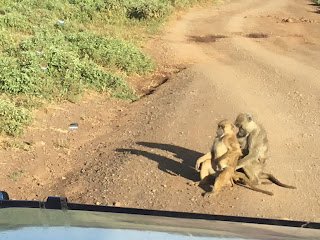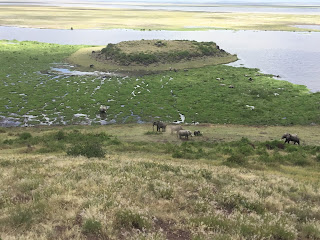up bright and early, after breakfast we hit the road. The drive being approximately 6 hours.
We travelled again through the Rift Valley, a different way to what we first came, then onto Nairobi for lunch.
We travelled mainly on tarred roads and had just 28kms of dirt road, believe me these roads are not pleasant with large potholes. The traffic and rules on the road leave a lot to be desired as well with an only two line highway, and so many trucks, the traffic is bedlam as well as overtaking onto oncoming traffic was quite alarming.
We did see quite a few trucks on their sides, tipped over due to the sharp decline on the verge.
We arrived into Nairobi at 1130hrs, safari vehicle was filled with diesel and we had lunch in a nice hotel. Security is everywhere, you need to go through guards, be scanned for weapons and boom gates to enter and you are checked at the door, as well as your hand luggage.
After a pleasant lunch we set off again to travel due south. After a full day of travelling we arrived into the park at 6.30pm. Checked into our glamping style accomodation, ready for a few drinks.
We will stay here for two nights and will do a full day game drive tomorrow, having a packed lunch in the park.
Raffertys rules on the road
A large amount of trucks coming from Uganda
They all have pertinent names on their trucks, the buses are also very colourful.
We saw a few funny sights on our road trip to Amboseli.
Our glamping style accomodation, Sentrim Amboseli.
Our room with full amenities
Inside our room
Time for a few drinks.
In the morning we were taken on an escorted walk to the viewing point for Mt Kilimanjaro
DH and I enjoyed the sight, a lovely setting.
Debra and Tony from Rockhampton, our travelling buddies.
The viewing point.
Crown primrose birds
Flamingos
The dirt tracks getting to the parks. (Main roads)
This is some of the roads we travelled, very rough.
Baboons on the road.
There are two cheetahs in the grass, our first sighting.
Zebras, quite a few with foal.
The water ways, lots of birds and flamingos
Gazelle on side of the road.
Observeration Hill, where we will have lunch, this is where the elephants live.
We had a morning tea stop here at Oltuka Lodge in the middle of the parkGreat african artifacts
DH near the bar we only had coffee.
We felt like royalty, this lodge was lovely, but we had the best view of Mount Kilimanjaro.
Madam Muck.
Photo opportunity with a Masai warrior, they are the loveliest people, so gentle.
Keeping the grass under control with machetes, hard work, this is how they also keep down the grass along the highways, no whipper snippets or tractor mowers, we were told this keeps quite a few people employed, boy their arms must get sore.
Let me share some facts about Amboseli National Park.
Amboseli National Park is 392sqkm, and has a clear sight of Mt Kilimanjaro, Africa’s highest mountain at 5896m. The waters of the mountain feed the seasonal swamps and marshes on which the game and birds that live in the park rely.
Mount Kilimanjaro is nearly always snow capped. The park takes its name from the seasonal lake, Amboseli, which in dry weather resembles a massive salt pan. In recent years it has become world famous as the home of herds of elephants, which lived here in comparative safety throughout the times of intense poaching during the 1980’s and early 1990’s.
The large herds of elephants can most often be found in the permanent swamps.
The marshlands
The little island in the marshlands
Home to a large herd of elephants
On top of observation hill.
The birds are iridescent colours.
A little information about the park
Observeration Hill
We were very close to the elephants, lots of babies.
Walking to the marshland
Our trek up to Observation Hill.
The elephants cross this deep marshland to go back and forth across to the island.
Having a good feed, lots of food about.
Some facts about Kilimanjaro
Whilst we were up on the observation Hill, we each witnessed an amazing sight. On the small island was a mother elephant with two older calves and two babies that appeared to be twins, she wandered up and down the shore to work out, where it was best to cross. The four of us were watching and thought she is not going to bring the tiny babies across the deep marshland, is she?
There was also another elephant not fully grown coming near so she chased it off.
After about 10mins, the mother entered the water with the two babies and the two older ones behind. We observed this wonder of nature for a full hour, whilst having lunch, losing sight of the twins, then they would reappear at her side or under her ears.
The mother led the way, eating as she was slowly making her way across, this was observed through my binoculars, (would have loved to have the professional photographer here). The twins would appear up near her ears, then go under, the two older calves at the back of the mother, also helped by pushing them along. When they all appeared on the shore we clapped and was so excited to witness such an event. We were also very pleased that the twins made it.
When we told our guide who chose not to walk up the hill, he did not believe that they were twins! We were trying to convince him otherwise, but still doubted us.
On leaving the marshland, we spotted an elephant research vehicle, so stopped and asked about the elephants and if they were twins, yes they were, one week old and the only third pair to be born in 50years, how lucky were we, even our guide was amazed. They also live on the island, so that may have not been their first crossing.
The bird life in this area is magnificent, during the wet season water birds may be found within the swamps and after the rains, it is a common sight to see large flocks of flamingo wading in the pools of water below the mountain. We had a very full day and spotted loads of animals, no lions, but plenty of elephants, ganu’s, huxbeest, gazelles, hippos, cape water buffalos, birds, bustards, storks.
A very enjoyable day was had by all. More adventures to follow, next day we travel to Taita Hills.












































No comments:
Post a Comment